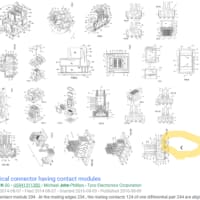US2020011561
5. The VRF system of claim 1, wherein the plurality of outdoor VRF units comprise a master outdoor VRF unit and one or more slave outdoor VRF units, the master outdoor VRF unit configured to:
【請求項5】
前記複数の屋外VRFユニットは、親機屋外VRFユニットと、1つ以上の子機屋外VRFユニットとを含み、
前記親機屋外VRFユニットは、
identify the new value of the pressure setpoint at the master outdoor VRF unit;
前記親機屋外VRFユニットにおいて前記圧力セットポイントの前記新しい値を識別することと、
use the new value of the pressure setpoint to operate the master outdoor VRF unit; and
前記圧力セットポイントの前記新しい値を使用して前記親機屋外VRFユニットを動作させることと、
communicate the new value of the pressure setpoint from the master outdoor VRF unit to the one or more slave outdoor VRF units.
前記親機屋外VRFユニットから前記1つ以上の子機屋外VRFユニットへと前記圧力セットポイントの前記新しい値を通信することと
を行うべく構成される、請求項1のVRFシステム。
WO2018111549
[0001] This disclosure relates generally to networking and more particularly relates to a mechanism for prioritized association between child devices and parent devices operating in a time slotted channel hopping IEEE 802.15.4 or IEEE 802.15.4e network.
本開示は一般的にネットワークに関し、子機と、IEEE802.15.4またはIEEE802.15.4eのタイムスロットチャネルホッピングネットワークにおいて動作する親機との間の優先アソシエーションのための機構に特に関する。
【背景技術】
【0002】
子機とタイムスロットチャネルホッピング(TSCH)ネットワークにおいて動作する親機との間の優先アソシエーションの確立のためのシステムおよび方法が提供される。
公益事業会社(utility company)、ホームオートメーションプロバイダ、産業オートメーションプロバイダ、科学および環境のアプリケーションプロバイダ、および他のリソースプロバイダは、TSCHネットワーク、例えば、IEEE802.15.4およびIEEE802.15.4(e)によって定義されたTSCHネットワークにおいて動作する装置を介して端点と通信しえる。
親機(例えば、電気計器、ルータ)はTSCHネットワークを介して接続されている。
ここでは、親機は親ノードまたはTSCHノードとも呼ばれる。
子機はリソース(例えば、電力、熱、水、他のユーティリティ、および他の種類のリソース)の使用量の監視および/または管理に利用される端点ノードである。
特定の態様において、子機(ここでは「子ノード」とも呼ばれる)はモノのインターネット(Internet of Things、IoT)の機能を有する装置であってもよく、当該装置はスマート電力網(smart power grid)およびスマートホーム技術に利用されうる。
子機は、TSCHネットワークの端点として利用され、電力使用量の読み取りおよび他のリソース情報についてのメッセージを親機と通信する。
他の態様において、子機はモバイル装置であってもよく、当該モバイル装置はTSCHネットワークにおいて1つ以上の親機のカバーレッジエリアを通過する。
WO2013161361
[00129] The main issues that need to be addressed by the bootstrapping process are: determining the role of the node, i.e.,
ブートストラップ処理で対処が必要な主な事項は、ノードの役割を決定すること、すなわち
discovering if the node is the gateway node; ensuring that no inter-node connections are established between nodes (parent-child relationship), before the parent is able to reach cloud service and provide general Internet access to Wi-Fi clients;
ノードがゲートウェイノードかどうかを発見すること;親機がクラウドサービスに到達でき一般的なインターネットアクセスをWi-Fiクライアントに提供できるようになるまでは、ノード間接続(親機-子機の関係)が決して確立されないようにすること;
and ensuring that every node will have a single path data path connection to the gateway node.
及びどのノードもゲートウェイノードへの単一経路のデータ経路接続を有することを保証すること、である。
[00133] When a Wi-Fi node senses(*現在形;完了形でもOK?)the Wi-Fi network with predefined SSID, it tries to connect to it, using Wi-Fi Protected Access (WPA)-Enterprise mode Wi-Fi protected access protocol (step 559).
Wi-Fiノードは、既定のSSIDでWi-Fiネットワークを検知すると、Wi-Fi Protected Access(WPA)-EngerpriseモードのWi-Fi保護アクセスプロトコルを用いてそれに接続しようとする(ステップ559)。
The parent access point 14 (which the Wi-Fi node connects to over Wi-Fi) first checks if the Wi-Fi node is in network whitelist (list is provided by the cloud service 504) (step 560).
親機アクセスポイント14(当該Wi-FiノードがWi-Fiで接続している)はまず、そのWi-Fiノードがネットワークホワイトリスト(リストはクラウドサービス504により提供される)に載っているかどうかをチェックする(ステップ560)。
If the Wi-Fi node is not in the list of allowed devices, the parent access point 14 will drop client connection. If the Wi-Fi node is in the list of devices allowed to connect to this Wi- Fi network, its credentials are transmitted by the parent access point 14 to the authentication service 502.
そのWi-Fiノードが許可されたデバイスのリストに載っていなければ、親機アクセスポイント14はクライアント接続を切断する。そのWi-FiノードがこのWi-Fiネットワークへの接続が許可されたデバイスのリストに載っていれば、その認証情報が親機アクセスポイント14によって認証サービス502に送信される。
There, the connecting device credentials are verified.
ここで、接続しているデバイスの認証情報が確認される。
Authentication results are shared back to the parent access point 14 using the Remote Authentication Dial-In User Service (RADIUS) protocol.
認証結果は、Remote Authentication Dial-In User Service(RADIUS)プロトコルを用いて親機アクセスポイント14に戻され共有される。
In case of successful authentication, the Wi-Fi node is allowed to connect to parent access point 14, whereas in case of failed authentication, the Wi-Fi node is blacklisted and denied a connection.
認証が成功した場合、Wi-Fiノードは親機アクセスポイント14への接続を許可されるが、認証が失敗した場合、Wi-Fiノードはブラックリストに載せられ、接続を拒否される。
Once allowed to connect, the Wi-Fi node receives the settings that were provided by the cloud service 504 to the gateway node (step 561).
接続が許可されると、Wi-Fiノードはクラウドサービス504によってゲートウェイノードに提供された設定を受信する(ステップ561)。
EP2961209
[0017] During a pairing, one of the devices is considered as the master device.
ペアリングにおいて、一方のデバイスがマスタ・デバイス(親機)と見なされる。
The master device is in charge of:
マスタ・デバイスは、
generating the pattern to be displayed on either of the master or slave device screen only or on the both screen;
・マスタ・デバイスのスクリーンとスレーブ・デバイス(子機)のスクリーンのいずれか一方のみに、あるいは、両方のスクリーンに表示されるパターンを生成すること、
communicating the screen pattern to the slave device;
・そのスクリーン・パターンをスレーブ・デバイスに伝えること、
collecting feedback information from the slave device;
・スレーブ・デバイスからフィードバック情報を収集すること、および、
analyzing this information to check the conformance of the user actions to the required traces.
・この情報を分析して、ユーザ・アクション(ユーザ操作)が必要なトレースに適合しているかを検査すること、
を担当する。
WO2013006234
In a variation of the system 100, at least a portion of the avatars may be devices separate from the patient interface devices 101 .
システム100の一変形では、アバタの少なくとも一部は、患者インタフェース装置101とは別の装置であってもよい。
In such a variation, the avatars may act as parent devices controlling one or more child patient interface devices.
このような一変形では、アバタは、1以上の子機である患者インタフェース装置を制御する親機として機能してもよい。
Fig. 1 C illustrates such a configuration where avatar 1 16 is a stand-alone device communicatively interconnected to patient interface device 101 a' and 101 b'.
図1Cでは、アバタ116がスタンドアローン装置であり、患者インタフェース装置101a’および101b’に通信可能に相互接続する構成を例示する。
Communications to the patient interface device gateway 104 would be managed by the avatar 1 16 which may be interconnected to the network 102.
患者インタフェース装置ゲートウェイ104との通信はアバタ116によって管理され、アバタ116はネットワーク102に相互接続してもよい。
Using the logic 1 15, the avatar 1 16 may generate patient-specific guidance data set 109a and patient-specific guidance data set 109b based on data within the database 1 14,
ロジック115を用いて、アバタ116は、患者固有のガイダンスデータセット109aおよび患者固有のガイダンスデータセット109bをデータベース114内のデータに基づいて生成してもよく、
and then transfer the patient-specific guidance data set 109a and patient-specific guidance data set 109b to the patient interface devices 101a' and 101 b', respectively.
次に、患者固有のガイダンスデータセット109aおよび患者固有のガイダンスデータセット109bを患者インタフェース装置101a’および101b’それぞれに転送してもよい。
WO2011070479
Among the functions that are mandatory for good operation in a wireless network is the maintenance of correct communication, which makes it possible to ensure at any time that a resource-restricted device is linked to a router, also called proxy, which forwards messages on its behalf.
無線ネットワークの良好なオペレーションのために必須の機能の中でも、リソース制限された装置が、代わりとしてメッセージを転送するルータ、いわゆるプロキシにリンクされることをいつでも保証することを可能にする正しい通信のメンテナンスがある。
In existing implementations therefore, a parent-child relationship is established between a device, generally resource-restricted, and its parent router. The child end device addresses all its communication to the parent for being forwarded to its final destination.
従って、既存の実行において、親-子関係が、一般にリソース制限された装置とその親ルータとの間で確立される。子機端末装置は、その最終の宛先へ転送されるため全ての通信を親機へアドレスする。
However, especially in case of energy-harvesting device, this relationship creates a single point of failure in the network, because if the parent link is broken, communication from the end device can not be successfully performed anymore.
しかしながら、特にエネルギー収集装置の場合、この関係は、親リンクが壊れた場合、端末装置からの通信がもはや上手く実施できないので、ネットワークの故障の単一のポイントを作る。
US2007183338
[0029] FIG. 3 illustrates frequency hopping on a time-frequency plane 300 for one piconet in a 79-hop Bluetooth system.
図3は、79ホップのBluetoothシステムにおける1つのピコネットについての時間周波数平面300上の周波数ホッピングを示す。
The piconet includes a master device and up to 7 actively communicating slave devices.
コネットは、1つのマスターデバイス(親機)と、活発に通信する7つまでのスレーブデバイス(子機)を含む。
The piconet is associated with a unique hopping sequence that is generated based on a pseudo-random algorithm defined by Bluetooth and with a unique address for the master device.
ピピコネットは、Bluetoothによって定義される擬似ランダムアルゴリズムに基づいて生成される特有のホッピングシーケンス(hopping sequence)と、マスターデバイスの特有のアドレスとによって関連づけられる。
The hopping sequence indicates a specific Bluetooth RF channel to use in each time slot.
ホッピングシーケンスは、各タイムスロットにおいて使用すべき1つの特定のBluetooth RFチャネルを指示する。
Since each time slot is 625 [mu]s, the Bluetooth RF channel used for transmission changes at a rate of 1600 times per second.
各タイムスロットは625μsであるから、送信のために使用されるBluetooth RFチャネルは毎秒1600回の割合で変化する。
The hopping sequence is designed to be random, to not show repetitive patterns over a short time interval, to hop equally across the Bluetooth RF channels over a short time interval, and to repeat over a very long time period.
ホッピングシーケンスは、ランダムになるように、短い時間インターバルで繰り返しパターンを示さないように、短い時間インターバルでBluetooth RFチャネルにわたって均等にホップするように、そして非常に長い時間期間で繰り返すように設計されている。
WO2006107662
The functionality in the stack 300 can be implemented, in part, by a unique namespace developed for the set-top box environment.
スタック300内の機能は、一部分において、セットトップボックス環境のために開発された独特な名前空間によって実装されることができる。
At its base, the namespace provides a shell, ABC__Co.TV.Lite. Shell, from which additional functionality can be appended in hierarchical fashion.
その名前空間の基底において、名前空間は、そのシェルから追加的な機能が階層的なやり方で付加されることができるシェル、ABC_Co.TV.Lite.Shellを提供する。
Child functionality in the hierarchy can rely on the tools provided by parent functionality through inheritance.
階層内の子機能は、継承によって親機能により提供されるツールを利用することができる。


























※コメント投稿者のブログIDはブログ作成者のみに通知されます